Significant Rise in Sava River Water Temperature in the City of Zagreb Identified across Various Time Scales
Abstract
1. Introduction
- (i)
- Analyze the long-term trends of the Sava River water temperature starting from 1948.
- (ii)
- Identify the relationship between the air temperature and water temperature of the river that flows through it.
- (iii)
- Analyze the relationship between air and water temperature on various time scales.
- (iv)
- Analyze the relationship between water temperature and Sava River flow rates on various time scales.
2. Data and Methods
2.1. Research Area and Problematics Description
2.2. Utilized Data with a Basic Description of Measurement Locations
2.3. Utilized Methods
3. Results and Discussion
3.1. Analyses on an Annual Time Scale
3.2. Analyses on a Monthly Time Scale
3.3. Analyses on a Daily Time Scale
4. Conclusions and Future Research Recommendations
Author Contributions
Funding
Data Availability Statement
Conflicts of Interest
References
- IPCC. Climate Change 2023: Synthesis Report. Contribution of Working Groups I, II and III to the Sixth Assessment Report of the Intergovernmental Panel on Climate Change; Lee, H., Romero, J., Eds.; IPCC: Geneva, Switzerland, 2023; pp. 35–115. [Google Scholar] [CrossRef]
- European Environment Agency. Water Temperature. Available online: https://www.eea.europa.eu/data-and-maps/indicators/water-temperature-2/assessment (accessed on 18 November 2021).
- Ficklin, D.L.; Hannah, D.M.; Wanders, N.; Dugdale, S.J.; England, J.; Klaus, J.; Kelleher, C.; Khamis, K.; Charlton, M.B. Rethinking river water temperature in a changing, human-dominated world. Nat. Water 2023, 1, 125–128. [Google Scholar] [CrossRef]
- Michel, A.; Schaefli, B.; Wever, N.; Zekollari, H.; Lehning, M.; Huwald, H. Future water temperature of rivers in Switzerland under climate change investigated with physics-based models. Hydrol. Earth Syst. Sci. 2022, 26, 1063–1087. [Google Scholar] [CrossRef]
- Nelson, K.C.; Palmer, M.A. Stream temperature surges under urbanization and climate change: Data, models, and responses. J. Am. Water Resour. Assoc. 2007, 43, 2. [Google Scholar] [CrossRef]
- Lessard, J.L.; Hayes, D.B. Effects of elevated water temperature on fish and macroinvertebrate communities below small dams. River Res. Appl. 2003, 19, 21–32. [Google Scholar] [CrossRef]
- Bonacci, O.; Đurin, B.; Roje-Bonacci, T.; Bonacci, D. The influence of reservoirs on water temperature in the downstream part of an open watercourse: A case study at Botovo Station on the Drava River. Water 2022, 14, 3534. [Google Scholar] [CrossRef]
- Xiao, Z.; Sun, J.; Yuan, B.; Lin, B.; Zhang, X. Roles of dam and climate change in thermal regime alteration of a large river. Environ. Res. Lett. 2022, 17, 094016. [Google Scholar] [CrossRef]
- Abdi, R.; Endreny, R.; Nowak, D.A. A model to integrate analysis of urban river thermal cooling in river restoration. J. Environ. Manage. 2020, 258, 110023. [Google Scholar] [CrossRef]
- White, J.C.; Khamis, K.; Dugdale, S.; Jackson, F.L.; Malcolm, I.A.; Krause, S.; Hannah, D.M. Drought impacts on river water temperature: A process-based understanding from temperate climates. Hydrol. Process. 2023, 37, e14958. [Google Scholar] [CrossRef]
- Večernji.hr. Pomor Ribe U Savi. Available online: https://www.vecernji.hr/vijesti/pomor-ribe-u-savi-716910 (accessed on 23 May 2002).
- Johnson, T.C.; Thomle, J.; Stickland, C.; Goldman, A.; Stegen, J. Riverbed temperature and 4D ERT monitoring reveals heterogenous horizontal and vertical groundwater-surface water exchange flows under dynamic stage conditions. Front. Earth Sci. 2022, 10, 910058. [Google Scholar] [CrossRef]
- Suárez, F.; Sandoval, V.; Méndez, A.S.; Muñoz, J.F. Investigating river–aquifer interactions using heat as a tracer in the Silala river transboundary basin. Wiley Interdiscip. Rev. Water 2023, 11, e1639. [Google Scholar] [CrossRef]
- Souaissi, Z.; Taha, B.M.J.O.; St-Hilaire, A. River water temperature quantiles as thermal stress indicators: Case study in Switzerland. Ecological Indicators 2021, 131, 108234. [Google Scholar] [CrossRef]
- Briciu, A.-E.; Dumitru, M.; Graur, A.; Oprea, D.E.; Prisăcariu, A.; Bistricean, P.I. Changes in the water temperature of rivers impacted by the urban heat island: Case study of Suceava City. Water 2020, 12, 1343. [Google Scholar] [CrossRef]
- Shrestha, R.R.; Pesklevits, J.C.; Bonsal, B.R.; Brannen, R.; Guo, T.; Hoffman, S. Rising summer river water temperature across Canada: Spatial patterns and hydroclimatic controls. Environ. Res. Lett. 2024, 19, 044058. [Google Scholar] [CrossRef]
- Ahmadi-Nedushan, B.; St-Hilaire, A.; Ouarda, T.B.M.J.; Bilodeau, L.; Robichaud, É.; Thiémonge, N.; Bobée, B. Predicting river water temperatures using stochastic models: Case study of the Moisie River (Québec, Canada). Hydrol. Process. 2007, 21, 21–34. [Google Scholar] [CrossRef]
- Laszewski, M. Stream water temperature: A short review with special reference to diurnal dynamics. Misc. Geogrphica 2013, 17, 34–41. [Google Scholar] [CrossRef]
- Van Vliet, M.T.; Franssen, W.H.; Yearsley, J.R.; Ludwig, F.; Haddeland, I.; Lettenmaier, D.P.; Kabat, P. Global river discharge and water temperature under climate change. Glob. Environ. Change 2013, 23, 450–464. [Google Scholar] [CrossRef]
- Cheng, L.; Guan, D.; Zhou, L.; Zhao, Z.; Zhou, J. Urban cooling island effect of main river on a landscape scale in Chongqing, China. Sustain. Cities Soc. 2019, 47, 101501. [Google Scholar] [CrossRef]
- Murakawa, S.; Sekine, T.; Narita, K.; Nishina, D. Study of the effects of a river on the thermal environment in an urban area. Energy Build. 1991, 16, 993–1001. [Google Scholar] [CrossRef]
- Wang, Y.; Ouyang, W.; Zhan, Q.; Zhang, L. The cooling effect of an urban river and its interaction with the littoral built environment in mitigating heat stress: A mobile measurement study. Sustainability 2022, 4, 11700. [Google Scholar] [CrossRef]
- Tavares, H.M.; Cunha, A.H.F.; Motta-Marques, D.; Ruhoff, A.L.; Fragoso, C.R., Jr.; Munar, A.M.; Bonnet, M. Derivation of consistent, continuous daily river water temperature data series by combining remote sensing and water temperature models. Remote Sens. Environ. 2020, 241, 111721. [Google Scholar] [CrossRef]
- Slukan Altić, M. Povijest regulacije rijeke Save kod Zagreba i njezine posljedice na izgradnju grada. Hrvatske Vode 2010, 18, 205–212. [Google Scholar]
- Pavlek, K. Utjecaj regulacija na promjene korita Save kod Zagreba od kraja 19. stoljeća do danas. Geografski Horizonti 2019, 65, 56–57. [Google Scholar]
- Biondić, D. Erozijski proces u savskom koritu kod Zagreba. In Zbornik Radova Okruglog Stola “Hidrologija i Vodni Resursi Save u Novim Uvjetima”; Trninić, D., Ed.; Hrvatsko Hidrološko Društvo: Zagreb, Croatia, 2000. [Google Scholar]
- Gilja, G.; Oskoruš, D.; Kuspilić, N. Erosion of the Sava riverbed in Croatia and its foreseeable consequences. In Proceedings of the 12th Conference on Water Observation and Information System for Decision Support, Ohrid, North Macedonia, 27 May–2 June 2012; Morell, M., Ed.; Faculty of Civil Engineering (Sts Cyril and Methodius University—Skopje): Skopje, North Macedonia, 2010; pp. 1–9. [Google Scholar]
- Kuspilić, G.; Gilja, G. Potencijalan Učinak Morfoloških Promjena Rijeke Save na Zagrebački Vodonosnik. Znanstveno-Stručni Skup: Strategija Razvoja Vodoopskrbe i Odvodnje Grada Zagreba; Andročec, V., Ed.; Društvo Građevinskih Inženjera: Zagreb, Croatia, 2016; pp. 13–22. [Google Scholar]
- Vujević, M.; Posavec, K. Identification of groundwater level decline in the Zagreb and Samobor-Zaprešić aquifers since the sixties of the twentieth century. Min. Geol. Pet. Eng. Bull. 2018, 33, 55–64. [Google Scholar] [CrossRef]
- Pavlić, I. Statistička Teorija i Primjena; Panorama: Zagreb, Croatia, 1965. [Google Scholar]
- Bonacci, O.; Andrić, I.; Roje-Bonacci, T. Increasing trends of air temperature in urban area: A case study from four stations in Zagreb city area. Vodoprivreda 2018, 50, 203–214. [Google Scholar]
- Bonacci, O.; Roje-Bonacci, T. Analyses of the Zagreb Grič observatory air temperatures indices for the period 1881 to 2017. Acta Hydrotech. 2018, 31, 67–85. [Google Scholar] [CrossRef]
- Bonacci, O.; Roje-Bonacci, T.; Vrsalović, A. The day-to-day temperature variability method as a tool for urban heat island analysis: A case of Zagreb-Grič Observatory (1887–2018). Urban Clim. 2022, 45, 101281. [Google Scholar] [CrossRef]
- Bonacci, O.; Đurin, B. The behavior of diurnal temperature range (DTR) and annual temperature range (ATR) in the urban environment: A case of Zagreb Grič, Croatia. Atmosphere 2023, 14, 1346. [Google Scholar] [CrossRef]
- McBean, E.; Bhatti, M.; Singh, A.; Mattern, L.; Murison, L.; Delaney, P. Temperature modeling, a key to assessing impact on rivers due to urbanization and climate change. Water 2022, 14, 1994. [Google Scholar] [CrossRef]
- Tone Mrtve Ribe Plutaju Savom: “Prve Lešine Smo Vidjeli Sinoć, Još Uvijek Dolaze Nove”—Doznali Smo Što se Događa. 22 July 2024. Available online: https://www.jutarnji.hr/vaumijau/aktualno/tone-mrtve-ribe-plutaju-savom-prve-lesine-smo-vidjeli-sinoc-jos-uvijek-dolaze-nove-doznali-smo-sto-se-dogada-15484777 (accessed on 25 July 2024).
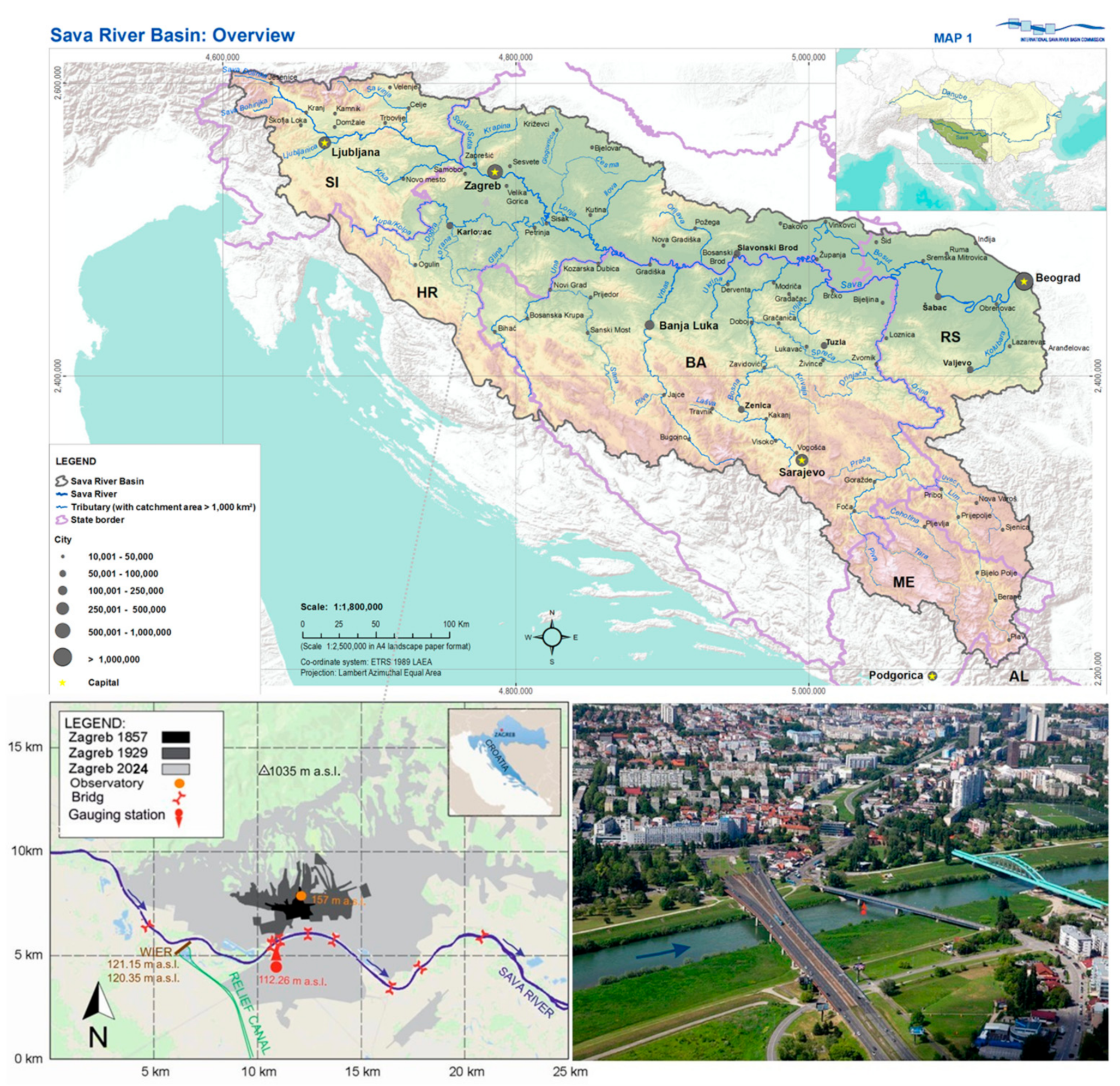

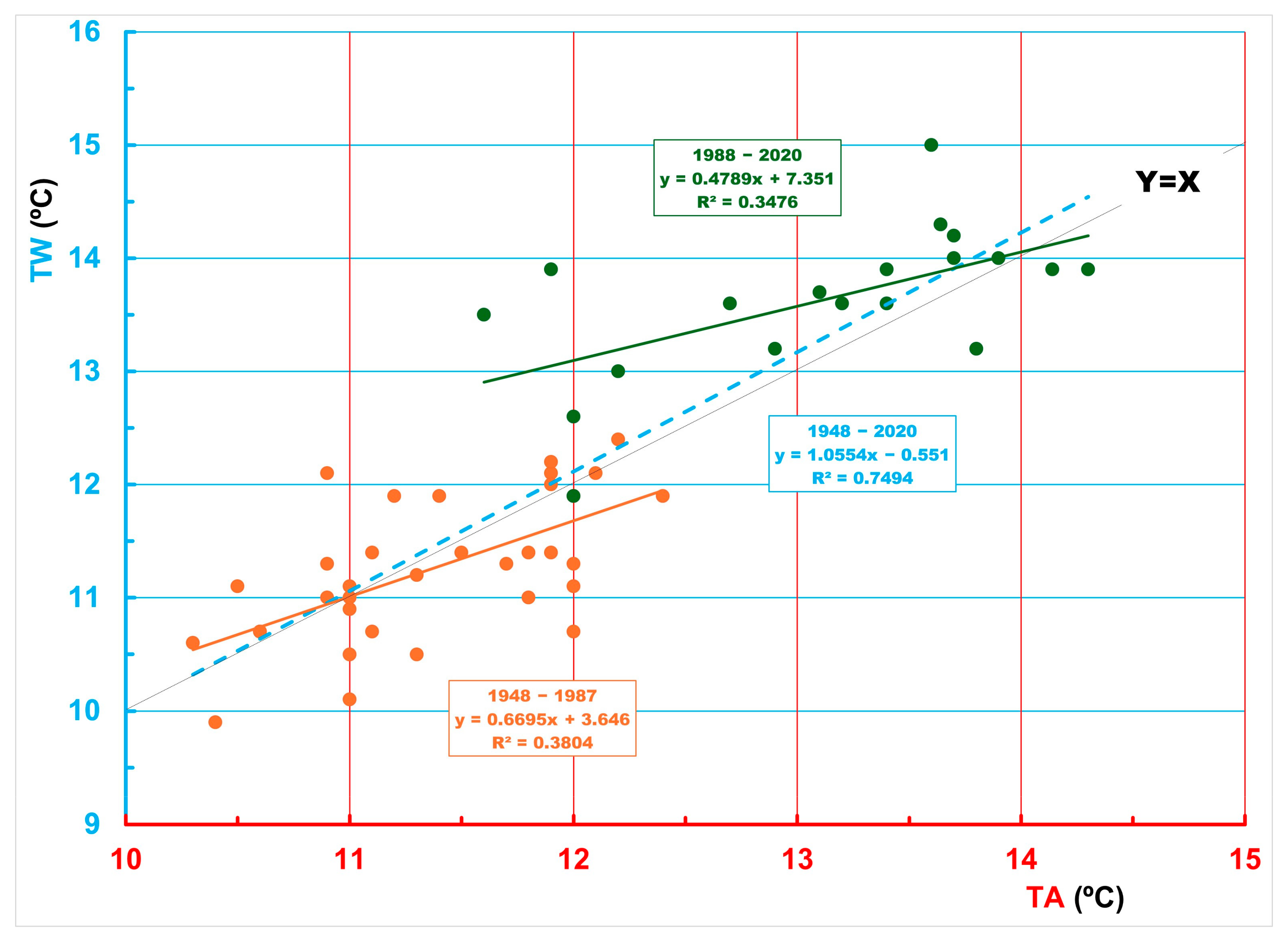
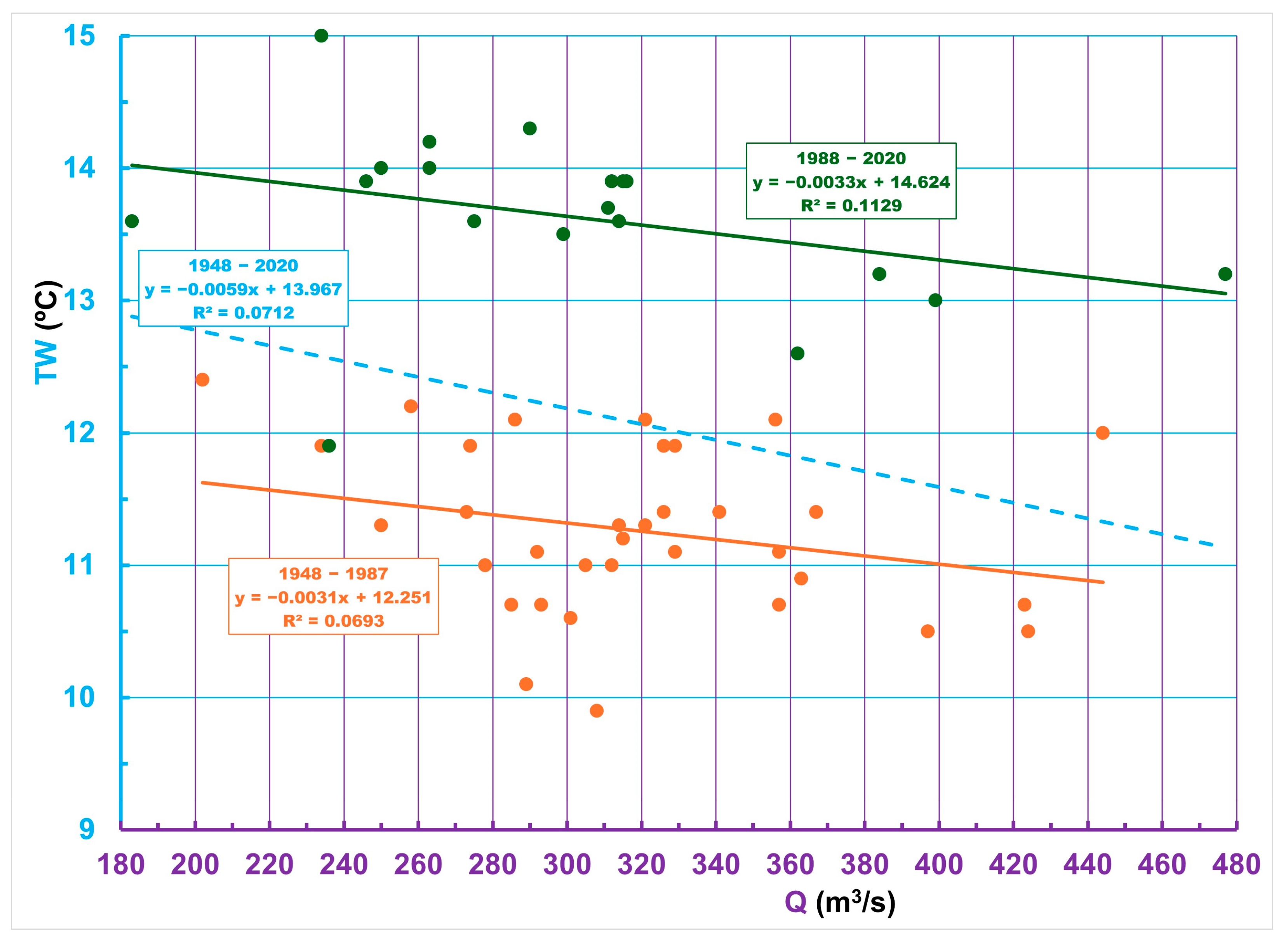
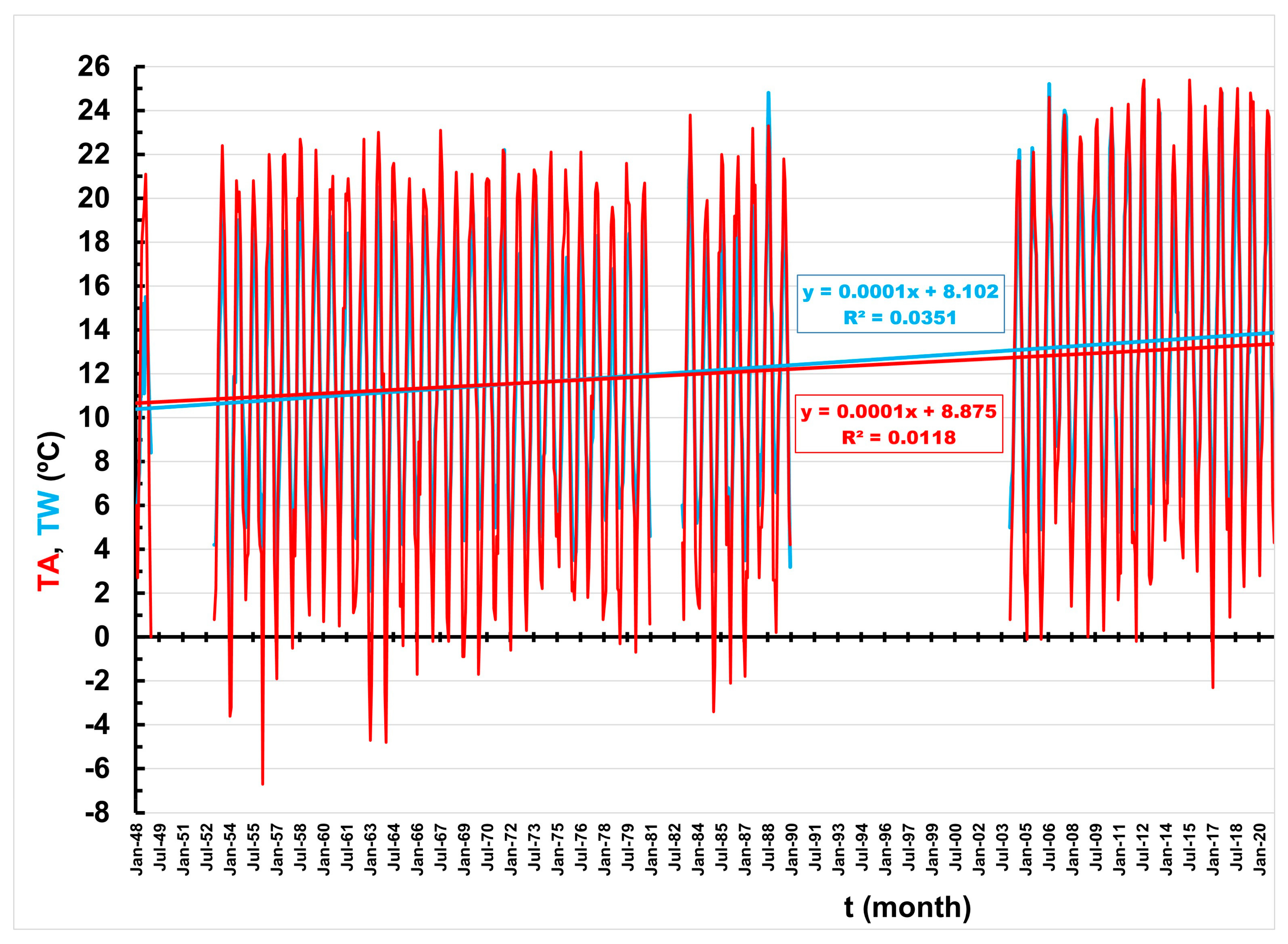


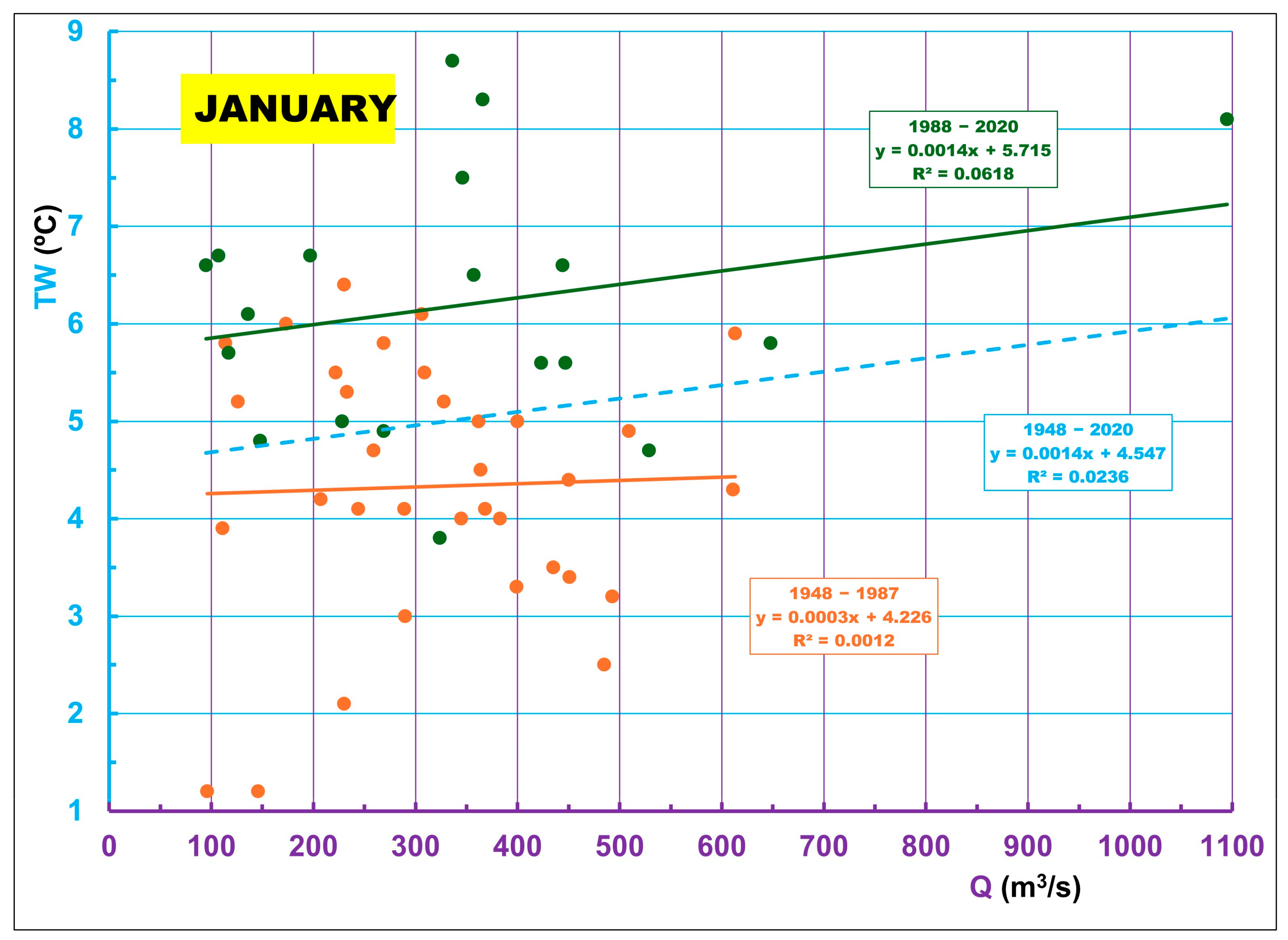

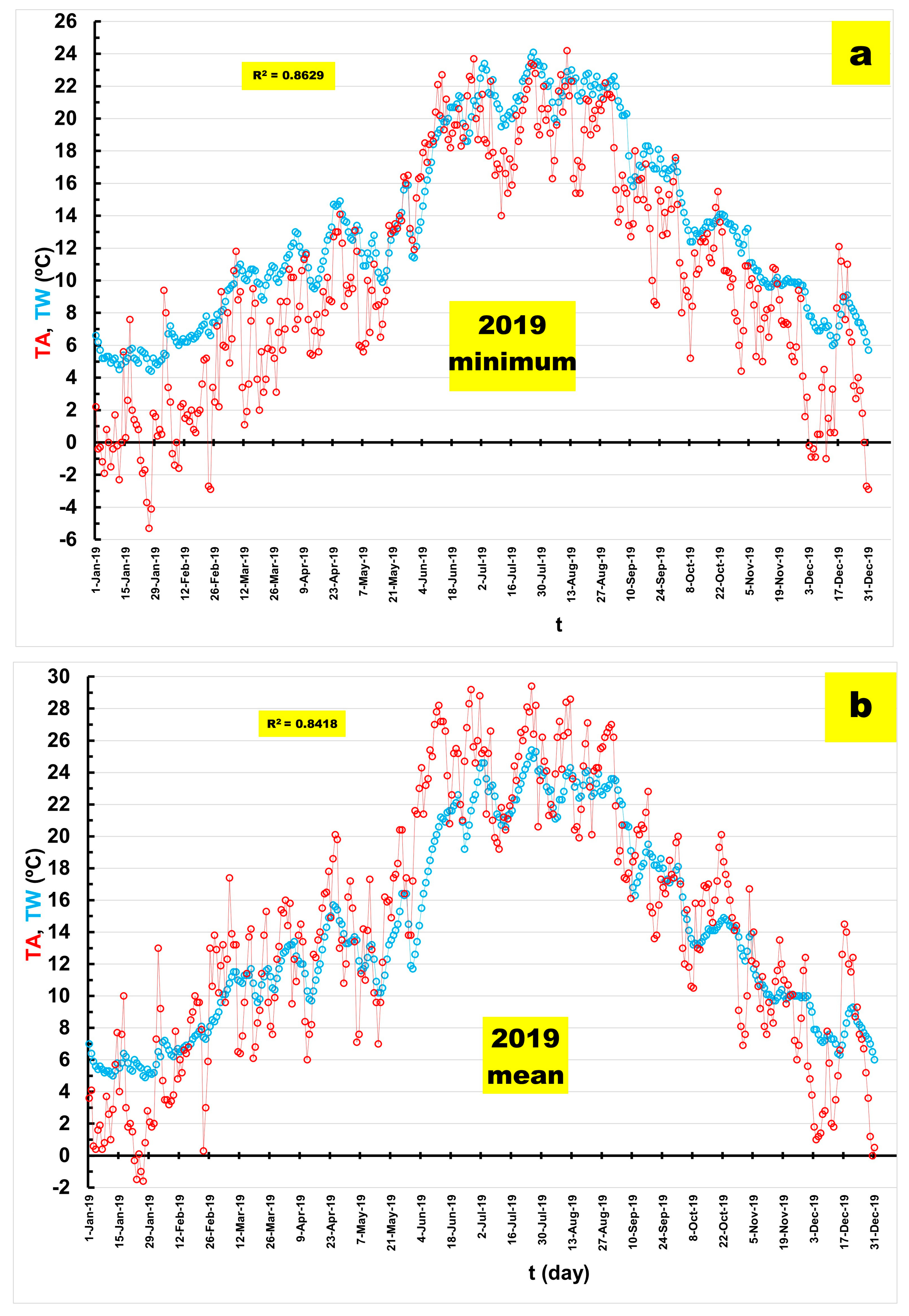
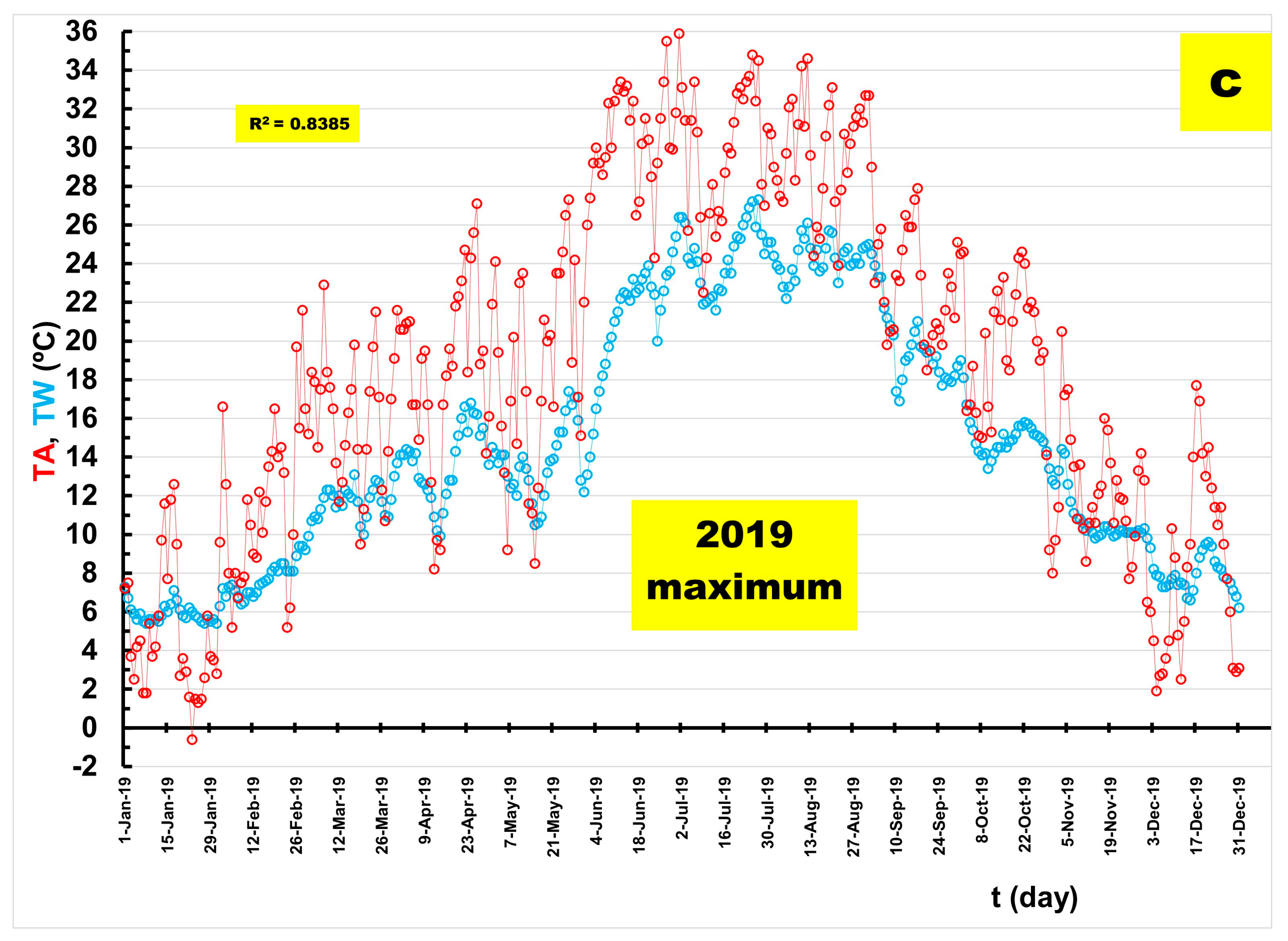
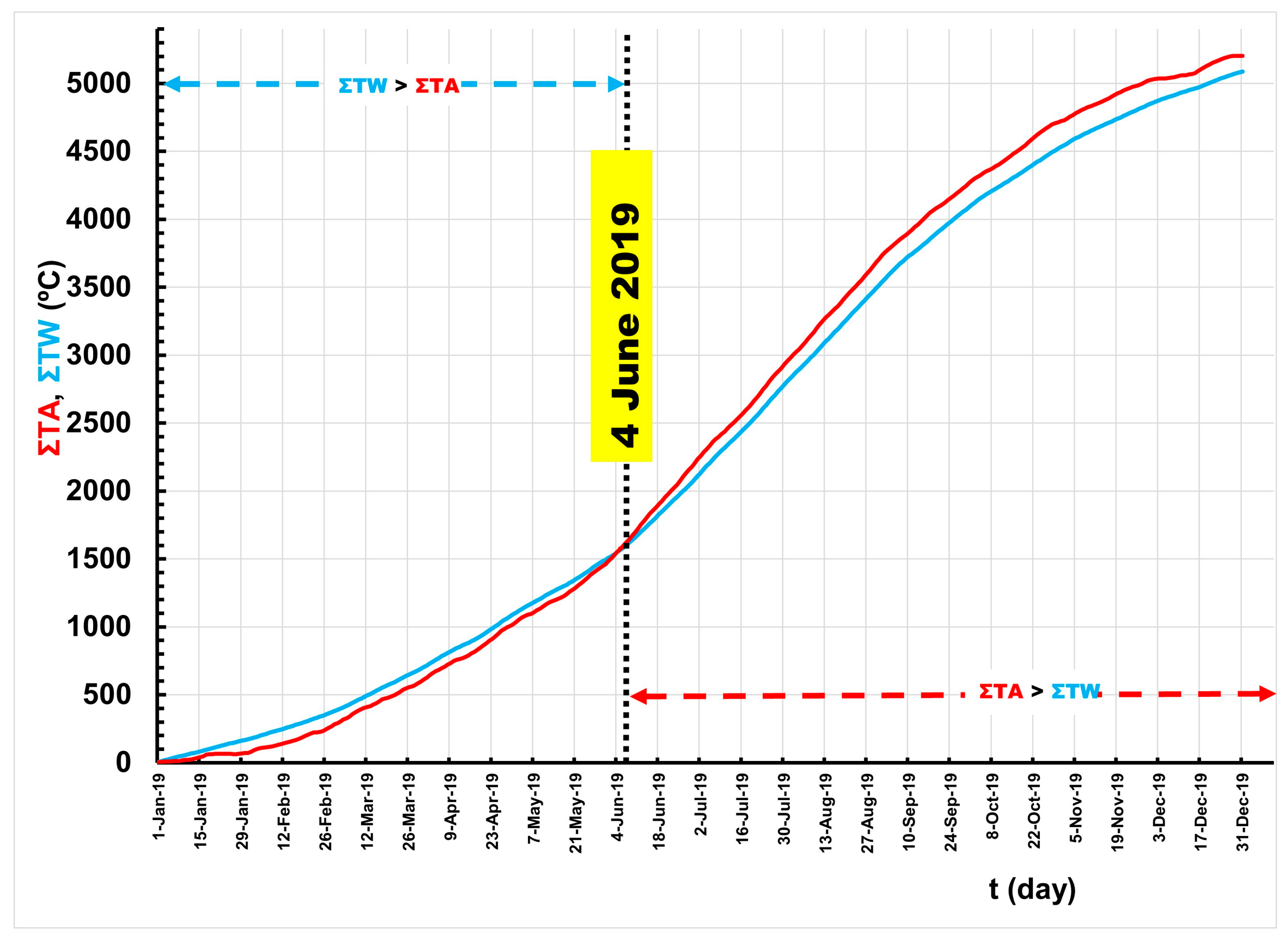
| °C | Minimum | Mean | Maximum |
|---|---|---|---|
| TW | 2.29 | 12.11 | 24.2 |
| TA | −10.12 | 12.00 | 33.8 |
| ΔT = TW − TA | 12.41 | 0.11 | −9.6 |
| °C | Minimum | Mean | Maximum | |||
|---|---|---|---|---|---|---|
| 1948–1987 | 1988–2020 | 1948–1987 | 1988–2020 | 1948–1987 | 1988–2020 | |
| TW | 1.79 | 3.18 | 11.26 | 13.63 | 22.9 | 26.7 |
| p | 9.0 × 10−4 | 1.1 × 10−17 | 4.2 × 10−11 | |||
| TA | −11.13 | −8.33 | 11.37 | 13.11 | 32.9 | 35.6 |
| p | 6.2 × 10−3 | 3.9 × 10−12 | 2.3 × 10−6 | |||
| ΔT = TW − TA | 12.94 | 11.39 | −0.05 | 0.43 | −9.89 | −9.03 |
| p | 0.088 | 9.8 × 10−3 | 0.060 | |||
| Month | Sub-Period | TW (°C) | ΔTW (°C) | p (F-Test) | p (t-Test) |
|---|---|---|---|---|---|
| January | 1948–1987 | 4.33 | 1.86 | 0.991 | 9.2 × 10−6 |
| 1988–2020 | 6.19 | ||||
| February | 1948–1987 | 5.04 | 1.69 | 0.370 | 1.9 × 10−4 |
| 1988–2020 | 6.73 | ||||
| March | 1948–1987 | 7.07 | 2.28 | 0.685 | 1.4 × 10−7 |
| 1988–2020 | 9.35 | ||||
| April | 1948–1987 | 10.22 | 2.62 | 0.597 | 4.0 × 10−9 |
| 1988–2020 | 12.84 | ||||
| May | 1948–1987 | 13.53 | 2.64 | 0.168 | 4.5 × 10−7 |
| 1988–2020 | 16.17 | ||||
| June | 1948–1987 | 16.38 | 3.44 | 0.480 | 2.0 × 10−9 |
| 1988–2020 | 19.82 | ||||
| July | 1948–1987 | 18.34 | 3.97 | 0.845 | 8.3 × 10−9 |
| 1988–2020 | 22.32 | ||||
| August | 1948–1987 | 18.55 | 3.66 | 0.104 | 8.1 × 10−10 |
| 1988–2020 | 22.21 | ||||
| September | 1948–1987 | 15.65 | 2.05 | 0.390 | 5.8 × 10−5 |
| 1988–2020 | 17.69 | ||||
| October | 1948–1987 | 11.86 | 1.68 | 0.185 | 9.5 × 10−6 |
| 1988–2020 | 13.54 | ||||
| November | 1948–1987 | 8.35 | 1.34 | 0.281 | 2.4 × 10−4 |
| 1988–2020 | 9.69 | ||||
| December | 1948–1987 | 5.70 | 1.18 | 0.906 | 1.5 × 10−3 |
| 1988–2020 | 6.88 |
| Year | N1 | N2 | ΔN = N1 − N2 |
|---|---|---|---|
| 2012 | 103 | 86 | 17 |
| 2013 | 90 | 83 | 7 |
| 2014 | 54 | 39 | 15 |
| 2015 | 94 | 83 | 11 |
| 2016 | 100 | 86 | 14 |
| 2017 | 112 | 104 | 8 |
| 2018 | 103 | 81 | 22 |
| 2019 | 97 | 89 | 8 |
| 2020 | 92 | 77 | 15 |
Disclaimer/Publisher’s Note: The statements, opinions and data contained in all publications are solely those of the individual author(s) and contributor(s) and not of MDPI and/or the editor(s). MDPI and/or the editor(s) disclaim responsibility for any injury to people or property resulting from any ideas, methods, instructions or products referred to in the content. |
© 2024 by the authors. Licensee MDPI, Basel, Switzerland. This article is an open access article distributed under the terms and conditions of the Creative Commons Attribution (CC BY) license (https://creativecommons.org/licenses/by/4.0/).
Share and Cite
Bonacci, O.; Žaknić-Ćatović, A.; Roje-Bonacci, T. Significant Rise in Sava River Water Temperature in the City of Zagreb Identified across Various Time Scales. Water 2024, 16, 2337. https://doi.org/10.3390/w16162337
Bonacci O, Žaknić-Ćatović A, Roje-Bonacci T. Significant Rise in Sava River Water Temperature in the City of Zagreb Identified across Various Time Scales. Water. 2024; 16(16):2337. https://doi.org/10.3390/w16162337
Chicago/Turabian StyleBonacci, Ognjen, Ana Žaknić-Ćatović, and Tanja Roje-Bonacci. 2024. "Significant Rise in Sava River Water Temperature in the City of Zagreb Identified across Various Time Scales" Water 16, no. 16: 2337. https://doi.org/10.3390/w16162337
APA StyleBonacci, O., Žaknić-Ćatović, A., & Roje-Bonacci, T. (2024). Significant Rise in Sava River Water Temperature in the City of Zagreb Identified across Various Time Scales. Water, 16(16), 2337. https://doi.org/10.3390/w16162337







